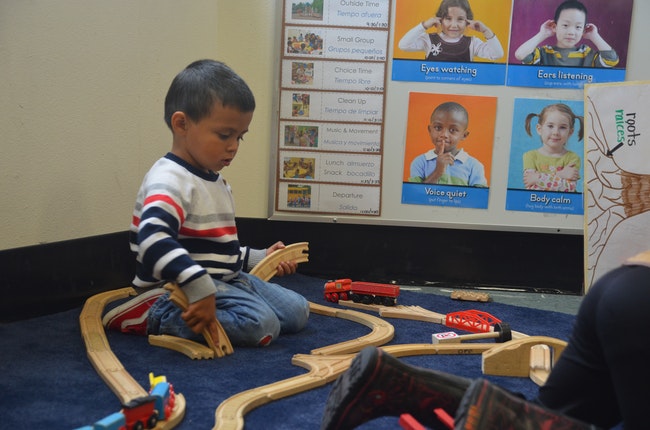A record number of Oregon families signed up for child care subsidies this year when eligibility was broadly expanded, but that has led to a budget shortfall that could reach $123 million.
Department of Early Learning and Care officials told a legislative committee last week that they stopped taking applications Nov. 4 for the state’s Employment Related Day Care program, which helps low-income families pay for child care. The pause in applications came months after the Legislature broadened eligibility to more families and increased benefits – but it didn’t allocate enough money to pay for them, forcing the agency to create a waitlist.
That’s frustrated recipients and child care advocates whose lobbying efforts failed to increase the program’s funding during this year’s legislative session.
The subsidy program pays for the bulk of child care costs for low-income families earning less than 200% of the federal poverty line, which is about $3,300 for a family of two. Families receiving the benefit only pay a monthly copay, which vary by income. The average was $10 in August.
The budget deficit means the waitlist for subsidized care will probably remain in place indefinitely, barring a major investment by the Legislature in the 2024 session. Even if the program doesn’t grow beyond its current caseload of 15,600 families – which is unlikely – funding is $38 million short. That figure excludes $13 million in federal funding the agency expects to receive.
That expected funding gap would spike to $123 million if the caseload grows by 2% per month, according to a presentation by state early learning director Alyssa Chatterjee and two of her aides.
Some lawmakers on the interim education subcommittee expressed concern about the budget shortfall. They also affirmed that assistance for day care is critical for families and employers in Oregon, where child care costs many families 20% of their income – if it is available at all.
“We need to make this program something that can’t surprise us,” said Rep. Susan McLain, D-Hillsboro.
In June, lawmakers appropriated about $113 million less for the program than what the Department of Early Learning and Care had requested. Gov. Tina Kotek, for whom early learning is a priority, called on lawmakers last month to commit at least $50 million more.
It’s unclear how much funding the early learning agency will ask for during the 2024 session, which kicks off in February. Kate Gonsalves, a department spokesperson, said analysts are “still working to finalize what that number will be.”
Dana Hepper, director of policy and advocacy at Children’s Institute, told the Capital Chronicle that Employment Related Day Care is “ready to grow” but needs support from lawmakers.
“That is not a sustainable strategy. And we know what to do. We know we have a program that works,” she said.
Deficit driven by caseload spike
During the presentation, Chatterjee told lawmakers that budgeting for the program has been difficult because it’s been impossible to project how many families would apply for subsidies under the expanded eligibility rules. She said she expected clarity to emerge in the coming months.
Hepper noted that the agency’s original budget request this year may have covered the current demand had it been approved.
“They might have gotten it kind of right back then,” she said.
Oregon has offered Employment Related Day Care subsidies for decades, but the program’s advocates long considered the program broken because it saddled recipients with exorbitantly high co-pays. In 2021, lawmakers reacting to the COVID-19 child-care crisis extended the program to serve more categories of low-income families. Students became eligible, as did families with an open child welfare case, families receiving federal assistance and survivors of domestic violence. Most of those changes went into effect this year, and more are planned.
The legislation also beefed up the subsidy by reducing families’ copays, which were some of the priciest in the country. The copay for an average family of three with one child in care was about $520 per month in 2019, according to a report by the National Women’s Law Center. Now, depending on monthly income, a family of that size can pay no more than about $110 per month.
To drive down co-pays and make the subsidy more useful for families, the state relied on about $97 million of federal American Rescue Plan Act funding. But the last of that funding will be spent within the year, Chatterjee told the Capital Chronicle last month, creating a funding “gap.”
Applications for subsidies spiked in June, just after state lawmakers committed much less funding than what the agency and advocates had asked for. That month, about 11,500 families participated in the program; by October, more than 15,600 families did. However, thousands of accepted families are still waiting to connect with a child care provider who accepts the subsidy.
“I’m also not surprised that we grew so quickly,” Rep. Emily McIntire, R-Eagle Point, said during the presentation. “This is something that our state has been begging for, that is long overdue.”
McLain reassured Chatterjee that Employment Related Day Care is “not the first program to have a waitlist.” She noted that the state’s two grant programs for electric vehicle purchases were quickly sapped this year and closed to new applications.
Oregon Capital Chronicle is part of States Newsroom, a network of news bureaus supported by grants and a coalition of donors as a 501c(3) public charity. Oregon Capital Chronicle maintains editorial independence. Contact Editor Lynne Terry for questions: [email protected]. Follow Oregon Capital Chronicle on Facebook and Twitter.
STORY TIP OR IDEA? Send an email to Salem Reporter’s news team: [email protected].









